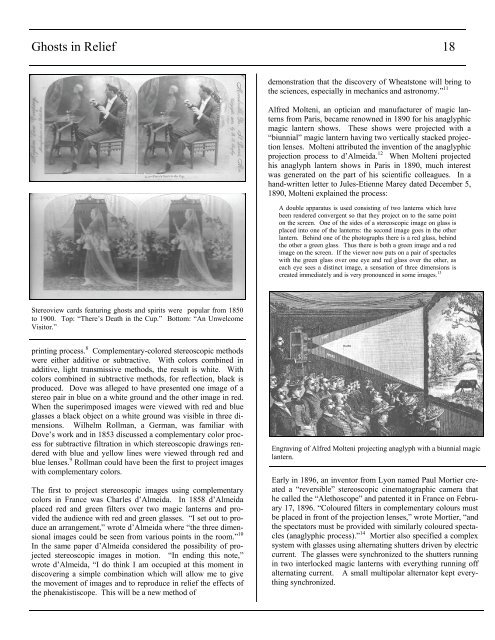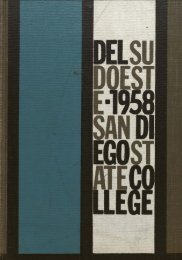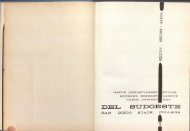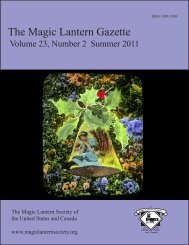The Magic Lantern Gazette - Library
The Magic Lantern Gazette - Library
The Magic Lantern Gazette - Library
You also want an ePaper? Increase the reach of your titles
YUMPU automatically turns print PDFs into web optimized ePapers that Google loves.
Ghosts in Relief 18<br />
demonstration that the discovery of Wheatstone will bring to<br />
the sciences, especially in mechanics and astronomy.” 11<br />
Alfred Molteni, an optician and manufacturer of magic lanterns<br />
from Paris, became renowned in 1890 for his anaglyphic<br />
magic lantern shows. <strong>The</strong>se shows were projected with a<br />
“biunnial” magic lantern having two vertically stacked projection<br />
lenses. Molteni attributed the invention of the anaglyphic<br />
projection process to d’Almeida. 12 When Molteni projected<br />
his anaglyph lantern shows in Paris in 1890, much interest<br />
was generated on the part of his scientific colleagues. In a<br />
hand-written letter to Jules-Etienne Marey dated December 5,<br />
1890, Molteni explained the process:<br />
A double apparatus is used consisting of two lanterns which have<br />
been rendered convergent so that they project on to the same point<br />
on the screen. One of the sides of a stereoscopic image on glass is<br />
placed into one of the lanterns: the second image goes in the other<br />
lantern. Behind one of the photographs there is a red glass, behind<br />
the other a green glass. Thus there is both a green image and a red<br />
image on the screen. If the viewer now puts on a pair of spectacles<br />
with the green glass over one eye and red glass over the other, as<br />
each eye sees a distinct image, a sensation of three dimensions is<br />
created immediately and is very pronounced in some images. 13<br />
Stereoview cards featuring ghosts and spirits were popular from 1850<br />
to 1900. Top: “<strong>The</strong>re’s Death in the Cup.” Bottom: “An Unwelcome<br />
Visitor.”<br />
printing process. 8 Complementary-colored stereoscopic methods<br />
were either additive or subtractive. With colors combined in<br />
additive, light transmissive methods, the result is white. With<br />
colors combined in subtractive methods, for reflection, black is<br />
produced. Dove was alleged to have presented one image of a<br />
stereo pair in blue on a white ground and the other image in red.<br />
When the superimposed images were viewed with red and blue<br />
glasses a black object on a white ground was visible in three dimensions.<br />
Wilhelm Rollman, a German, was familiar with<br />
Dove’s work and in 1853 discussed a complementary color process<br />
for subtractive filtration in which stereoscopic drawings rendered<br />
with blue and yellow lines were viewed through red and<br />
blue lenses. 9 Rollman could have been the first to project images<br />
with complementary colors.<br />
<strong>The</strong> first to project stereoscopic images using complementary<br />
colors in France was Charles d’Almeida. In 1858 d’Almeida<br />
placed red and green filters over two magic lanterns and provided<br />
the audience with red and green glasses. “I set out to produce<br />
an arrangement,” wrote d’Almeida where “the three dimensional<br />
images could be seen from various points in the room.” 10<br />
In the same paper d’Almeida considered the possibility of projected<br />
stereoscopic images in motion. “In ending this note,”<br />
wrote d’Almeida, “I do think I am occupied at this moment in<br />
discovering a simple combination which will allow me to give<br />
the movement of images and to reproduce in relief the effects of<br />
the phenakistiscope. This will be a new method of<br />
Engraving of Alfred Molteni projecting anaglyph with a biunnial magic<br />
lantern.<br />
Early in 1896, an inventor from Lyon named Paul Mortier created<br />
a “reversible” stereoscopic cinematographic camera that<br />
he called the “Alethoscope” and patented it in France on February<br />
17, 1896. “Coloured filters in complementary colours must<br />
be placed in front of the projection lenses,” wrote Mortier, “and<br />
the spectators must be provided with similarly coloured spectacles<br />
(anaglyphic process).” 14 Mortier also specified a complex<br />
system with glasses using alternating shutters driven by electric<br />
current. <strong>The</strong> glasses were synchronized to the shutters running<br />
in two interlocked magic lanterns with everything running off<br />
alternating current. A small multipolar alternator kept everything<br />
synchronized.
















